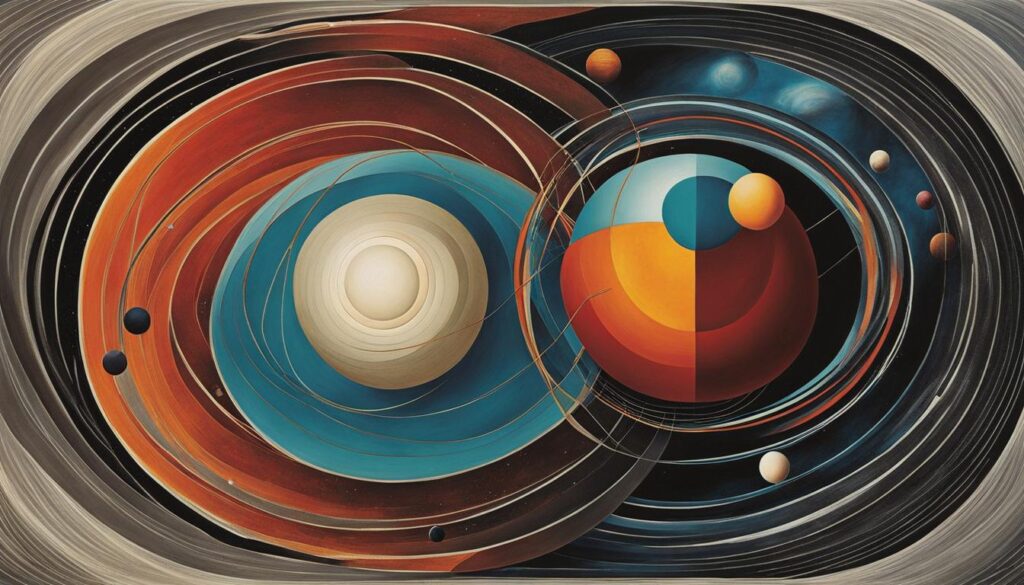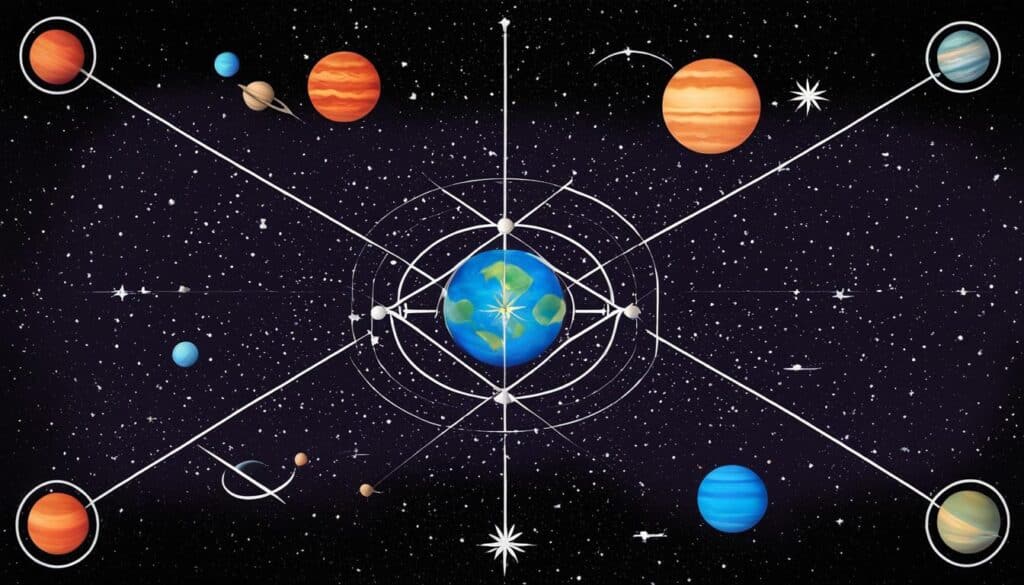What Is Inconjunct in Astrology?
When you delve into the complexities of your astrological chart, have you ever encountered a term that left you baffled—like ‘inconjunct’? Often overlooked, the inconjunct aspect significance in astrology is a subtle and profound influence that can shape your personality and relationships in unexpected ways. An inconjunct, also known as a quincunx, forms a 150-degree angle between planets in zodiac signs that are five signs apart. These hard aspects result in a dynamic that may feel akin to conversing in different languages—each sign expressing itself in a manner that’s inherently foreign to the other. To grasp the full impact of this aspect, understanding inconjunct in astrology becomes essential.
This curious and often challenging relationship may initially present as a series of misunderstandings or an ongoing need for adjustment. But don’t be discouraged! Unraveling the enigma of inconjuncts unlocks a deeper awareness of how unique energies interact and influence your life’s story.
Key Takeaways
- Defines the peculiar 150-degree aspect known as the inconjunct or quincunx.
- Unveils the noteworthy role of inconjuncts in individual natal charts.
- Sheds light on the elemental and modal differences creating tension in inconjunct aspects.
- Encourages a deeper dive into astrological studies for a clearer understanding of inconjunct relationships.
- Highlights the importance of resolving conflicts and fostering growth through inconjunct challenges.
The Basics of Inconjunct Aspects in Astrology
When you delve into the complexities of astrology, the inconjunct aspect, often overlooked, can significantly influence your natal chart. An inconjunct—also known as a quincunx—is established when two planets are exactly 150 degrees apart. Grasping the inconjunct meaning in astrology involves understanding the subtle but impactful ways it colors your astrological experience.
Understanding the 150-Degree Angle
The inconjunct astrology symbol, a line with an upside-down ‘V’ attached, mirrors the aspect’s character—a connection that’s not immediately apparent but significant in its demands for adjustment. The inconjunct definition in astrology relates to a unique tension and potential for growth, inherent in its 150-degree angle that essentially forces two distinct energies to acknowledge and accommodate one another.
Identifying Inconjunct Signs
Navigating your chart, you may wonder what is inconjunct in astrology concerning zodiac signs. To identify these relationships, find the sign directly opposite your point of reference and then look to the signs directly before and after this opposite sign. Take Aries, for example: its inconjunct counterparts are Virgo and Scorpio. This trio exemplifies the inconjunct aspects meaning—each pairing is a call for awareness and aptitude in balancing otherwise discordant elements.
- Aries must balance with the detail-oriented Virgo and the transformative Scorpio.
- Taurus finds its inconjunct challenge in the balancing acts with Libra’s harmony and Sagittarius’ adventure.
- Gemini, with its diversity in thought, needs to manage the depth of Scorpio and the discipline of Capricorn.
Each of these astrological dynamics prompts you to confront and reconcile areas of your life, which may require a conscious effort of integration. It’s through understanding inconjunct aspects and their nuanced influence that you can facilitate personal development and harmony.
Interpreting the Inconjunct’s Influence on Personalities
As you delve deeper into the world of astrology, you’ll discover that the inconjunct aspects interpretation can reveal much about a person’s complex personality. These inconjunct planetary aspects often show up as conflicting traits within a birth chart, reflecting the intricate human psyche. Imagine someone with a Sun in carefree, communicative Gemini and a Moon in the deep, intense waters of Scorpio. This person may often experience internal dichotomies and feel the tension of embodying both flexibility and intensity within their essence.

The inconjunct represents parts of you that don’t necessarily agree with each other. It’s like having a committee in your head where members speak different languages. Some of these might include:
- A push-and-pull between desiring change and clinging to stability.
- A tug-of-war between a need for social interaction and a craving for solitude.
- An inner dialogue between adventurous risk-taking and cautious strategizing.
The key to inconjunct planetary aspect mastery lies in recognizing these varying parts of yourself and finding ways to let them coexist or, even better, collaborate. It’s a challenging task, but one that can lead to a greater sense of wholeness and self-awareness. You might find that this process of internal negotiation can ultimately become one of your greatest strengths.
What Is Inconjunct in Astrology: Core Meaning and Symbolism
As you delve deeper into the mysteries of astrology, you may encounter the term “inconjunct,” a vital piece of the cosmic puzzle. Understanding the inconjunct aspects interpretation is like uncovering a secret language of the stars, shedding light on the nuanced dynamics that influence your life. These aspects, often not as immediately recognized as, say, trines or squares, carry a complex symbolism that can reveal the intricate tapestry of your personality and relationships.
Defining Inconjunct in Zodiac Relationships
An inconjunct in astrology represents a challenging angle, signaling a need for adjustment and adaptation. When inconjunct aspects come into play, they engage two zodiac signs that may not naturally resonate with one another, compelling them to find a middle ground. Imagine a conversation where two people speak different languages, the inconjunct aspect is the interpreter that urges them to seek understanding.
The Hard Aspect of the Quincunx
In astrological terms, the inconjunct aspect in astrology doesn’t just hint at minor tweaks but signifies a robust and dynamic tension. Known also as a quincunx, this “hard aspect” is akin to tough love in cosmic form—it demands work but promises growth. Reflect upon the feeling when two seemingly disjointed areas of your life force you into a balancing act; this is the essence of a quincunx. With a balanced interpretation and approach, these aspects can become a source of profound personal development and understanding.
The Role of Inconjunct in Transits and Synastry
When you explore the multifaceted world of astrology, the inconjunct aspect stands out, particularly during the times of synastry and transits. Whether you’re discovering how planetary movements interact with your natal chart or delving into the dynamics between two people’s charts, inconjuncts can provide valuable insights into the unique challenges and adjustments required in relationships.

In synastry, which is the art of chart comparison, an inconjunct might highlight areas where you and a partner are out of sync. It’s akin to speaking different love languages — where intentions are pure but interpretations differ. Perhaps you’re a detail-oriented Virgo with a penchant for clear communication, while your partner’s Sagittarian energy thrives on grand gestures and big-picture ideas. The inconjunct between your signs would call attention to the need for finding common ground.
When it comes to transits, which are the current or upcoming planetary movements, inconjuncts mark periods of life that may feel like walking a tightrope. Imagine Saturn is transiting in opposition to your natal Venus, demanding structure where you seek pleasure. A transit like this could evoke a period of growth through tension, urging you to balance discipline with your desire for harmony and affection.
- Recognizing the Inconjunct: Be mindful of the days when the inconjunct appears in transits, as they may bring forth lessons in flexibility and adaptation.
- Communicating Openly: Focus on opening dialogue in relationships influenced by an inconjunct aspect to ensure both parties are heard and understood.
- Embracing Change: Use the energy of inconjuncts to facilitate growth, as these astrological moments encourage shifts in perspectives and behaviors.
Ultimately, the role of the inconjunct in astrology is to remind us that life is a series of adjustments. Whether through the lens of synastry or the current transits, inconjuncts serve as opportunities to learn, improve, and ultimately, to understand the complex dance between different energies in our lives and relationships.
Navigating Inconjunct Aspect Challenges in Life
When you encounter inconjunct aspects within your astrological chart, you’re often signing up for an insightful but demanding course in personal adjustment. The inconjunct, or quincunx, might make you feel like you’re always compensating for something just out of reach. It’s akin to walking a tightrope between two vastly different energy poles, striving for balance despite a gusty wind of discordance.
The key to navigating these astrological waters is understanding inconjunct in astrology – what it involves and how it influences your life narrative. From your internal battles to external relationships, the inconjunct’s subtle but persistent pull can often be the source of profound growth and self-discovery.
Making Adjustments and Embracing the Inconjunct
Your pathway through the inconjunct’s demands is unique, calling for innovative solutions. Let’s break down essential strategies for effective inconjunct aspects interpretation:
- Acknowledge the presence of disparate energies – Doing so can prevent the internal strife that often accompanies inconjuncts.
- Be prepared for continuous self-evaluation – Adjustments might not be a one-time event but a process that evolves with your experiences.
- Seek creative compromises – Since standard solutions may not apply, finding middle ground often requires out-of-the-box thinking.
- Advocate for your personal development – Embrace the inconjunct as a catalyst for growth rather than a hindrance.
By cultivating awareness and a willingness to integrate this complex aspect into your being, you morph challenges into stepping stones. Instead of being an astrological curveball, the inconjunct becomes a testament to your resilience and a badge of honor in the story of your life’s journey.
Inconjunct Aspects and Relationship Dynamics in Astrology
In the complex dance of interpersonal connections, inconjunct aspects in astrology shed light on the more nuanced steps. You might wonder how this inconjunct definition in astrology factors into your everyday interactions. When these 150-degree angles grace your chart, they don’t just sit idly by; they actively pinpoint areas where you and those close to you might stumble in offering support or articulating affection in ways that resonate with each other. It’s like trying to blend two distinct dance rhythms — it can take a while before you move in sync.
However, there’s a silver lining that’s often overlooked. Although the inconjunct astrology symbol signifies demanding adjustments, it’s precisely these challenges that can act as catalysts for profound growth and self-discovery in a relationship. Imagine unlocking a trove of understanding simply by navigating the choppy waters of differing values and perspectives. With a bit of patience and a lot of heart, the discordance marked by inconjuncts transforms into harmony, allowing relationship dynamics to evolve from potentially contentious to constructively compelling.
Remember, every aspect in your astrological playbook, including those perplexing inconjunct angles, serves a distinct purpose. They reveal the deep and sometimes difficult lessons of compromise and compassion that ultimately fortify bonds. So, as you chart your course through the constellations of connection, respect the role these aspects play in your relationship dynamics; they’re there not to hinder, but to help navigate the river of human emotion and understanding.
FAQ
What is an inconjunct in astrology?
An inconjunct in astrology, also known as a quincunx, is a planetary aspect that occurs when two planets are 150 degrees apart, signifying challenging relationships between zodiac signs five signs apart. It represents a need for adjustment and is considered a significant aspect in shaping an individual’s natal chart and inter-personal relationships.
How do you understand the 150-degree angle in inconjunct aspects?
The 150-degree angle in an inconjunct aspect occurs when the planets involved are positioned five zodiac signs apart from each other. This angle creates a tension that suggests a disconnect or a lack of common characteristics between the signs, requiring adjustments and understanding to harmonize the conflicting energies.
How can you identify inconjunct signs?
To identify inconjunct signs, you can locate the sign opposite to a given zodiac sign and then consider the two adjacent signs. For instance, if you’re looking at Aries, then Virgo and Scorpio would be in an inconjunct relationship with it. Each zodiac sign has two signs that it is inconjunct with on the zodiac wheel.
What influence does the inconjunct have on personalities?
Inconjunct aspects in astrology can reveal contradictory or opposing traits within an individual’s personality. Those with inconjuncts in their natal charts may experience internal conflicts and feel a need to reconcile different parts of their identity or behavior that seem at odds with each other.
What is the core meaning and symbolism of an inconjunct in zodiac relationships?
In zodiac relationships, an inconjunct signifies the challenge and discomfort that can arise when trying to blend the energies of two signs with little in common. The core symbolism of the inconjunct aspect is the adjustment and compromise required to overcome misunderstandings and differences in approach.
Why is the quincunx considered a ‘hard aspect’ in astrology?
The quincunx is considered a ‘hard aspect’ because it denotes tension and potential conflict between two planetary energies that have little to no commonality. It challenges individuals to work harder to integrate these disparate energies within their lives, much like other hard aspects such as squares and oppositions.
What role do inconjunct aspects play in transits and synastry?
Inconjunct aspects play a significant role both in transits, which are the movements of planets at the current time, and in synastry, which is the comparison of two astrological charts to assess compatibility. Inconjuncts may indicate areas where mutual understanding and adaptation are necessary within a relationship, or they could reveal timing issues and challenges in a person’s life due to current planetary influences.
How can one make adjustments and embrace the inconjunct in life?
Embracing an inconjunct involves awareness of the internal and relational challenges it presents, and actively seeking to integrate the conflicting energies. This often requires making personal adjustments, learning to balance different parts of the self, and employing creativity and flexibility to navigate life’s complexities presented by inconjunct aspects.
How do inconjunct aspects affect relationship dynamics in astrology?
Inconjunct aspects can complicate relationship dynamics by emphasizing areas where partners struggle to understand each other’s needs and ways of expressing affection. However, addressing these challenges with empathy and willingness to change can lead to growth and a deeper understanding within the relationship, contributing to stronger bonds and individual development.







